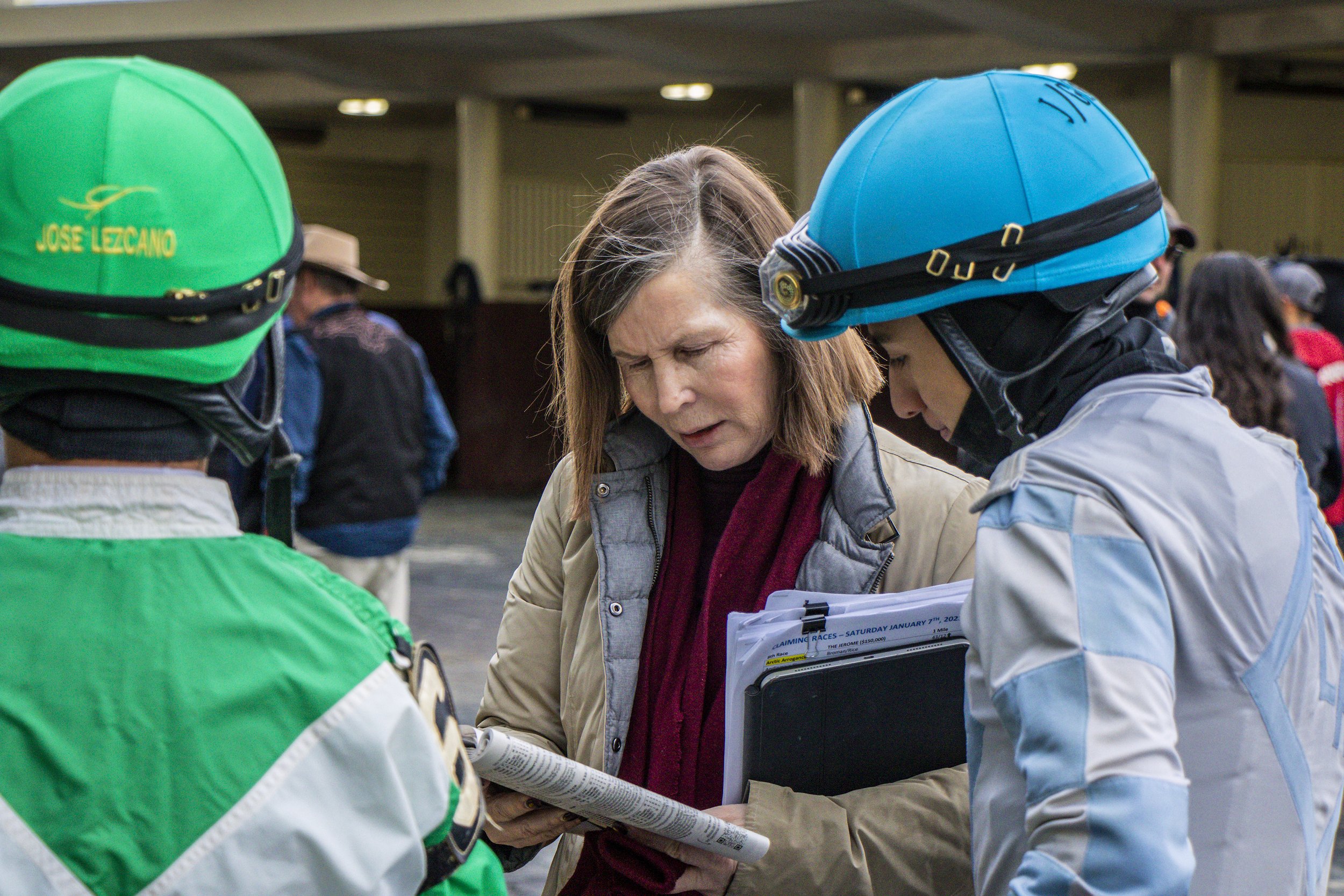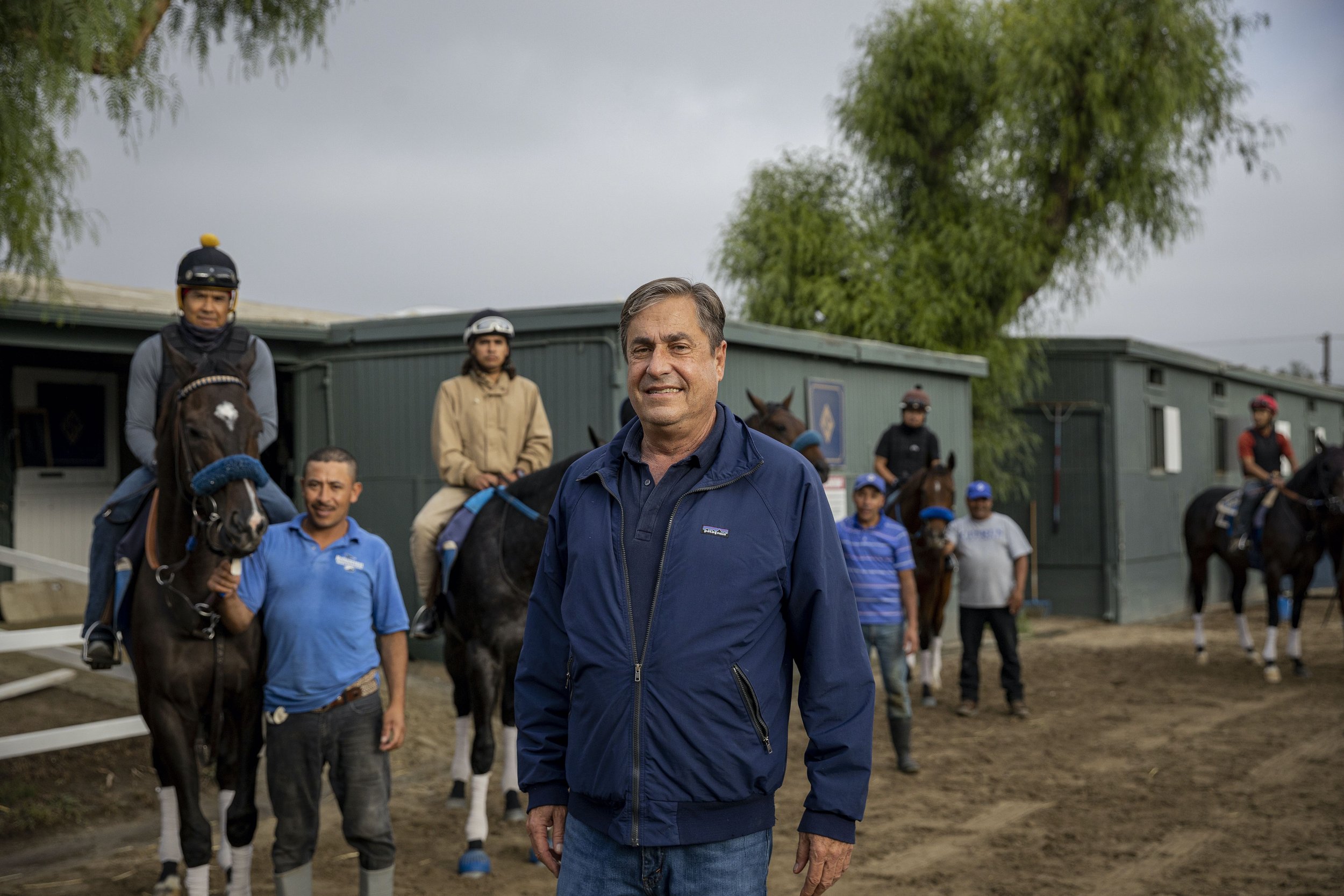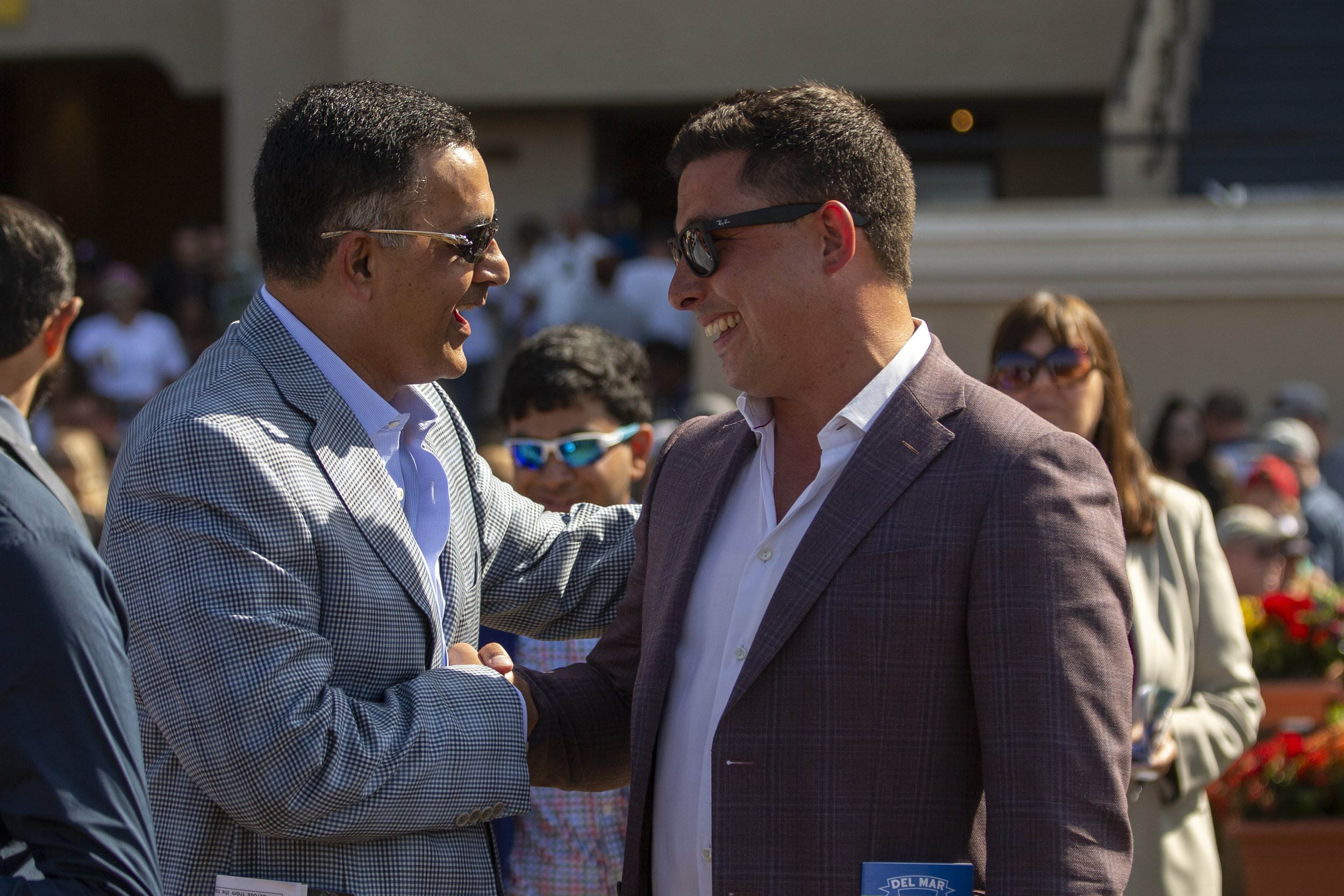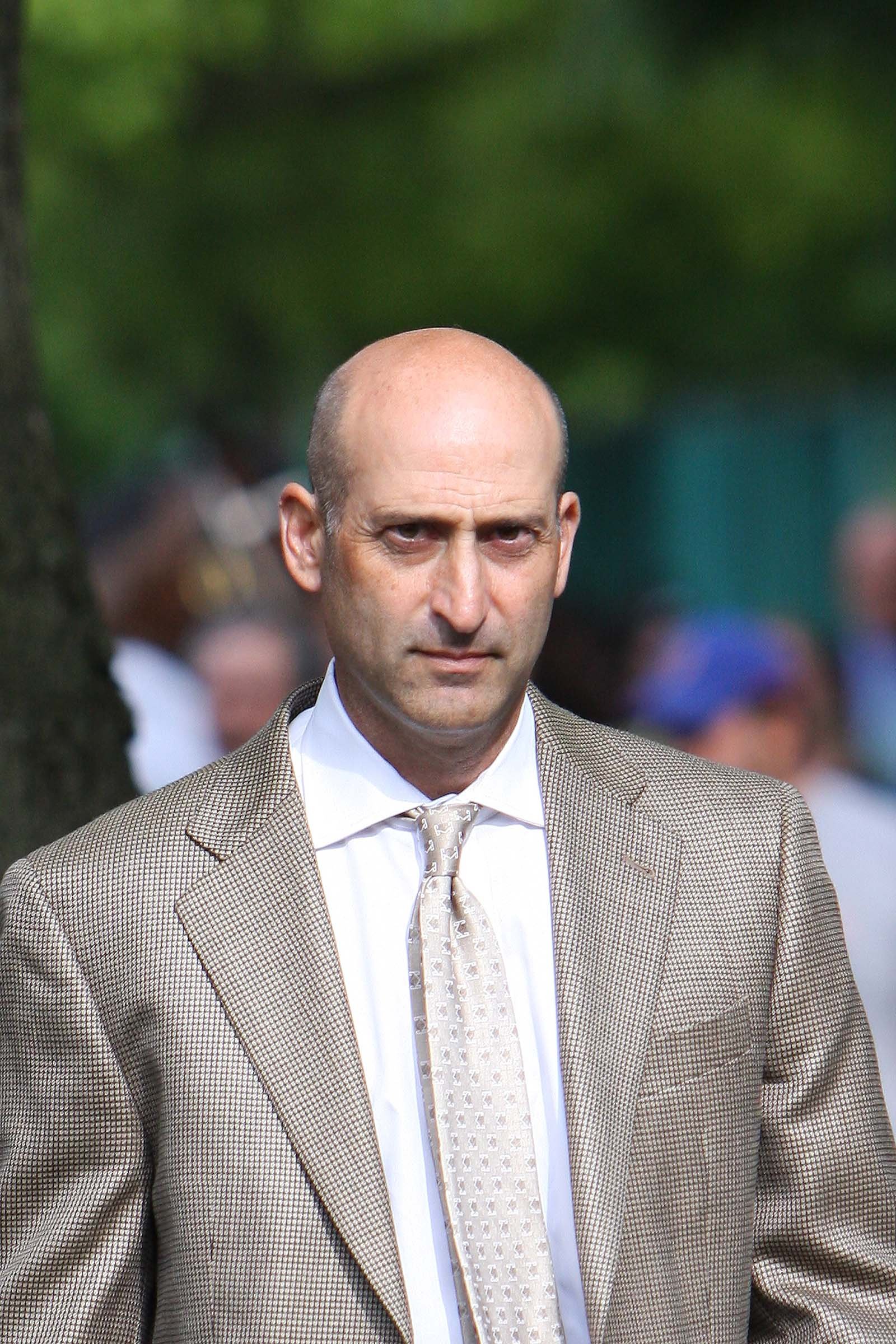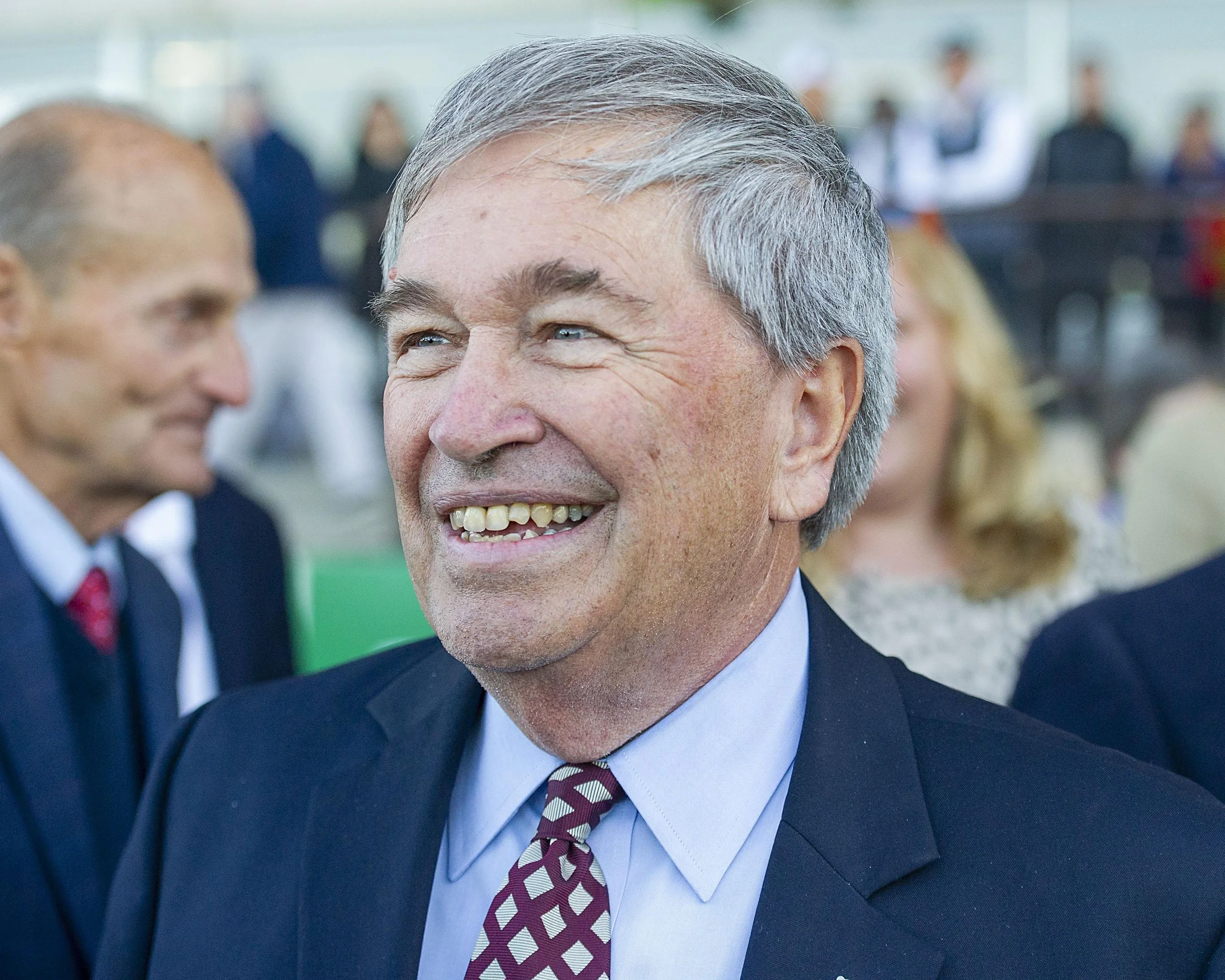#Soundbites - What do you look for when you evaluate a yearling at sales, and are there sire lines that influence your opinions?
Linda Rice
Linda Rice
I look for a good shoulder, and usually that will transcend into a great walk, an athletic walk. I do that for the length of stride. I like to buy young mares. Of course I have preference for some stallions I have had success with like City Zip. And then stallions everybody likes: sons of Into Mischief, sons of Curlin, sons of McLain’s Music. I’ve done well with them. If they have a great shoulder and a great walk, I’ll take a shot on an unproven stallion.
Brad Cox
The first thing, from a physical standpoint, is you have to consider his size. Is he too big or too small? As far as sire lines, you’re looking for signs. You totally have to have an idea what the yearling will look like. Will he look like his sire? You pay attention.
Graham Motion
Graham Motion
I think many of us get influenced by stallions’ progeny that we have trained before. There are other ones that we avoid if we haven’t done well with a sire’s prodigy. I think the one thing I look for is athleticism in general. I’m not overly critical of conformation.
John Sadler
John Sadler
We’re looking primarily for dirt pedigrees for California. I have a good idea what works here, what doesn’t work here. Obviously, I’m partial to some of the sires I trained, Twirling Candy, Accelerate, and Catalina Cruiser who’s off to a very fast start. On the conformation side, I look for a well-conformed horse that looks like an athlete. As an experienced trainer, you look for any little things. You learn what you can live with or without. Then, obviously, I’m looking for Flightlines in a couple of years!
Simon Callaghan
Simon Callaghan
Generally, I’m looking for an athlete first and foremost. Conformation and temperament are two major factors. Yes, there are sire lines I like—not one specific one. Certainly it’s a relatively small group.
Tom Albertrani
Tom Albertrani
I’m not a big sales guy, but when I do go, I like to look at the pedigree first. Then I look for the same things as everyone else. Balance is important. I like to see a horse that’s well-balanced, and I like nicely muscle-toned hindquarters.
Michael Matz
One of the things, first of all, is I look at the overall picture and balance. We always pick apart their faults, then what things that are good for them. You look for the balance, then if they’re a young yearling or an older yearling. Those are some of the things I look at. If you like one, you go ahead. There are certain sires if you have had luck with them before. It all depends on what the yearling looks like. I would say the biggest things I look at are their balance and their attitude. When you see them come out and walk, sometimes I like to touch them around the ear to see how they react to that. That shows if they’re an accepting animal.
#Soundbites - What do you think racing will be like five years from now?
By Bill Heller
Todd Pletcher, Hall of Fame trainer
It’s difficult to project, but I think we’re going to continue to see what we’ve seen the past five years: a reduction in the tracks that are open. I think we’ll see continued growth in gambling, period. I think racing is benefitting from that—an open mindedness to gambling. Everyone now is gambling on football—pretty much on everything. One thing that grew during the pandemic was gambling. There will be fewer tracks but more of them operating successfully.
One thing we need to do is continue to make improvements on safety.
Assuming it (the HISA) goes through, it’s a good thing for the sport. We need some uniformity. It’s very difficult as a trainer to keep track of all the different rules in every jurisdiction. It should level the playing field.
Graham Motion, trainer
I hope, once we have the Horse Racing Integrity (and safety) Act in place, we’ll be in a better place five years from now. There will be smaller foal crops and less racetracks but a better product—one with more integrity. The status quo is unacceptable. It’s almost impossible to keep up with the different rules. We need uniformity and integrity, and right now we have neither.
Kelly Breen, trainer
I think what we saw in the pandemic was that people are betting—maybe more online. So many people learned how to bet on their phones and iPads during the pandemic that we’re setting record handles.
On track, you go to Saratoga, and it was mobbed. On the blue ribbon days, everybody is going to show up. I’m at the Keeneland Sales, and you can’t raise your hand. Racing is good. If you can get a good legislative body, and get everybody together for where we need to be in the next five years so you don’t have different rules on medication, the good horseman will be around.
Cliff Sise, Jr., trainer
Will we be here in five years? They are just tearing it apart. In New York, they have great purses now, but the new governor wants to take all that money and spend it otherwise. If that happens, purses will go so low. In California, Del Mar does well, but we don’t have the contract to get the purses up to where they should be. Owners are getting disgusted. We’re all shaking our heads wondering if we’ll be here in five years. It depends a lot on governors. If they look down on us, they can just say no more horse racing. PETA is watching us. We’re under the microscope so much. It’s a tough game to enjoy anymore.
Eric Jackson, Oaklawn Park Senior Vice President
Five years is a pretty short time from now. There will be fewer tracks than today, but those that survive the withering will be better than before. Sports are popular. I think it will be quality over quantity. In any sport, there’s demand to see it at a better level.
Chris Merz, Director of Racing, Santa Anita
I’m going to shed a positive light. I’m hoping this new bill puts everybody on the same page with the same rules. Then we can coordinate post times so they don’t conflict. It will be an industry working together to help the industry. We need to make this work. I think we’ve seen what happens when we don’t.
Michael Dubb, owner
There will be more consolidation, and we’ll be probably at the infancy of a marriage to legalized sports betting providers. I think that’s the future of racing. Anything that grows handle is probably good. You get a sports provider and a content provider, and the future will be TVG horse shows—you get on somebody’s platform. Do I want to bet if it’s sunny or cloudy? Do I want to bet football? Here’s horse racing. Do I want to bet that? think that’s the future of racing. Twenty years ago, we didn’t know the future of racing would be iPads. That’s how it turned out.
Barry Schwartz, owner and former CEO of the New York Racing Association
A lot has changed because of the pandemic. I think it exposed people to gambling on the Internet. Handle is everything. To me, right now, racing looks very alive and well. You see what’s going on at Keeneland. They’re already way past last year. Critical to racing is HISTA. They’ve got to get that up and running so the public has more confidence in racing, and that racing is legitimate. I think if we have a real strong organization in place, it will make people a lot more confident about racing—about racing being legitimate. The bottom line is I see a lot of things to be happy about with racing going forward. I didn’t feel that way five years ago.
Nick Cosato, owner
I would like to think we’re headed in the right direction with the Integrity Act. I’m optimistic.
Jack Knowlton, owner
I’m optimistic that racing will be in a better place in five years than it is today. In part, I do believe that the federal legislation will allow more resources to do the kind of testing we need to stay one step ahead of the cheaters. One of the big things is we never had enough resources to do the research. They’re coming up with new stuff to cheat. In my mind, that’s the biggest issue racing is facing. I think you’re going to have owners feeling better about participating.
And we’ll have one set of rules. The other thing, and we’ve made strides, is the issue of safety. We look at the data, and we’re getting a lot better, but there’s more work to be done. We have to continue to improve it. That’s definitely going in the right direction. The other issue is after-care, making sure we find a place for these athletes when they’re done with their careers.
#Coronavirus Soundbites
By Bill Heller
We asked trainers how they are handling the coronavirus pandemic and what advice they have for getting through this ordeal
Todd Pletcher
We had to close down our Belmont division. There were workers with symptoms. They went to the clinic and were quarantined. More than anything, it was making it difficult to have a safe workplace. At that time, we thought there wasn’t going to be racing in New York for a while. We had 20 horses at Belmont. That normally would be the time we’d be sending horses to Belmont. We had to put that on hold.
We left it up to owners to decide what to do with their horses. Some went to their farms; a couple went to Fair Hill; some went to Ocala and some went to Palm Beach Downs. We did not move any workers [but] have about 100 horses at Palm Beach, a small string at Gulfstream Park [and] four at Oaklawn scheduled to run. We’ve been fortunate with Gulfstream being able to run. We’ve been able to keep some schedules. It’s juggling a lot of schedules. It’s trying times for everyone. We want to make sure to keep our horses and our employees healthy.
Current practices at Palm Beach?
We’re just going by the recommendations as to what the government is saying. Masks are optional. Some are wearing them; most are not. At Gulfstream, we’re just trying to use common sense, keep people from congregating, keep six feet apart. The one thing we are learning is that social distancing is working. We try to keep that policy in mind.
Planning ahead?
That’s something I have to work around. I’m a target-oriented trainer. I like pointing to specific spots. At Aqueduct, the condition book is in the garbage—Keeneland, too. These are unique times. You have to adjust on a daily basis. Everyone’s in the same boat. Everyone’s facing several challenges.
Suggestions?
Use common sense. Take care of your horses and your staff. In time, we’ll return to normalcy. Try to remain positive.
*******************************************
Eoin Harty
It’s been no harder for me than everybody else. You worry about your family, in California and Europe. Every day you wake up, that’s the first thing on your mind. With horses, you have to take care of them every day. It would be a lot worse for me if we were home 24-7.
Eoin Harty
Precautions?
You can feel that tension in the air. I check every person in the barn; nobody’s coughing. Everyone is wearing gloves and masks—masks for sure around the barn. You don’t have to ask people twice.
Racing?
There’s been a lot of speculation about Santa Anita using Los Alamitos. I don’t know if it’s viable. I think we could be racing at Santa Anita again. The best case scenario is racing at the end of the month or in May. We haven’t had a single case on the racetrack. There hasn’t been a single one. That’s a good thing.
Personally?
I keep six feet away—don’t touch anything.
Suggestions?
Do what you have to do to protect yourself and your family. Right now, it’s common sense. Look out for your friends. Racing will take care of itself.
***************************************
Graham Motion
Graham Motion
My family is all home. My wife is trying to run the business from home. As far as the barn, we’re taking a lot of precautions. We have one person disinfecting everything first thing in the morning and last thing in the evening. He takes everybody’s temperature when they come in the morning. We’re trying to have employees not group up in the tack room. After a week or two, you have to remind them.
Six feet away?
We try to. It’s not totally realistic. You have to give a leg up. Most of the time with gloves. We try to do the best we can.
We’re going to try to get everybody to wear masks. We tried to order some. We have 100 employees all told at all the locations: Fair Hill, Palm Meadows. Normally, we would have pulled out from Palm Meadows for Keeneland, but now we’re staying at Palm Meadows.
Normally I train down there while my son, Chappy, goes to spring break. We got from Fair Hill to North Carolina. We planned to overnight in North Carolina. Once we got there, things were getting bad. We spent two nights in North Carolina, and we decided we’d rather be in Maryland. We went back to Fair Hill. It kind of reminded me of 9-11.
Advice for horsemen?
I think in general, the horsemen are lucky. We get to keep on doing what we do. The horses have to get out of their stalls. I think the unsettling part is not knowing when we’ll race again. We worry about our owners who are paying training fees every day. I’m worried about them. We have 60 horses at Fair Hill and 20 at Palm Meadows. I just brought in a few two-year-olds.
When new people come in, they stay away for two weeks. We’re trying to follow the guidelines.
***************************************
Tom Proctor
I’m in a little better shape than most. Other than Gulfstream and Tampa Bay, I have horses at Oaklawn, and the rest are at Glen Hill Farm south of Ocala. Most of my horses are gathered up at Ocala. We probably got 25 in Ocala and a dozen are at Tampa Bay. I’m spending most of my time in Ocala.
Precautions?
We did have horses at the Fair Grounds. We kept those people from Fair Grounds separate for two weeks. We did get out of New Orleans pretty early—about the middle of March.
Tom Proctor
In Ocala, gloves and masks?
Most of our people don’t leave the farm. We’re not really wearing masks. We’re washing our hands. The zip code we’re in hasn’t had a single case.
When you go to the track, do you take precautions?
I’ve stayed away from people—social distancing when I can. For a trainer, it’s easier than most. I check on the horses when nobody else is around.
**************************************
Tom Amoss
(Tom Amoss was exposed to the virus by being with New Orleans Saints Coach Sean Payton, who contracted the virus, at the Fair Grounds. Amoss self-quarantined for two weeks while continuing to work from home for TVG.)
Did you have the virus?
I never really found out. When it happened, it wasn’t easy to test. I stayed at home for two weeks. Now I’m going to work every day. They really don’t want us up and around in New Orleans. I’m here at my barn every morning from 6-10. My routine is the same.
Protocols at Fair Grounds?
That’s an evolving thing. Our temperature is taken when we come into the track. We’re not allowed in the buildings. Social distancing is a requirement. Fifty percent of the people on the backstretch are wearing masks. We’ve had zero issues in my barn, and none in other barns as well. There’s a reason for that. My help lives on the racetrack. They’re self-contained. There’s a grocery on the backstretch—Canseco’s. We’re the opposite of how New Orleans is doing. We have nothing bad in our barn. I haven’t heard of one case.
Suggestions for other horsemen?
It’s a tough question. Look, there’s a difference between our horses and the horses in California. Our horses are allowed to ship to Oaklawn. No people are shipped. I’ve got a barn up there. I’m blessed in the fact that I already have people there.
Stables?
Ever-changing. There are a lot of horses I have who race on grass. They have been sold or turned out. Other horses who don’t fit the condition and book at Oaklawn have been sold or turned out. We’ve down-sized about 20 percent.
****************************************
Linda Rice
Linda RIce
Handling this?
We’re doing very well. We’re being very careful on Long Island. We know New York City has a lot of cases. We’ve been using masks, gloves and social distancing. We’ve been doing that for three weeks now. We have a regular training schedule at Belmont. It’s good to have a routine. We’re happy to go to work every day. A lot of people are stuck at home. They can’t work. We can.
Response so far?
The help is doing great. Everyone is concerned. We watch the news. It scares the hell out of you. But it’s the old adage: the outside of a horse is good for the inside of a man, or a woman.
What’s going on with racing in New York?
Aqueduct, obviously, is being used as a hospital. I think everyone here is under the impression that we’ll be racing at Belmont. It’s just a matter of when. We’re looking at June 1st. If it’s sooner than that, great.
Outlook?
The entire world is dealing with this. If there is small business assistance, that’s great if it can get processed. Unemployment for those out of work will help. We’re making sure of helping everyone on the backstretch who needs it. We’re making sure our horses and our people are safe.
#Soundbites - Is there too much racing?
By Bill Heller
Once upon a time, racing in most locations had an off-season. That created anticipation for its return. In the Northeast, when racing only lasted from March through November, you actually missed it in the off months, and you got really pumped up for its return. Those days are long gone.
Racing these days is year-round, and some tracks offer massive cards on Saturdays, as many as 14 races a day instead of eight or nine.
So we asked trainers: Is there too much racing?
*********************************************
Bob Hess Jr.
I don’t think there’s too much racing. But I think nowadays, eight, nine races a day with huge fields is ideal, not 12. I think the average person doesn’t want to be stuck there for more than three hours. In terms of promoting it with young people, eight would be ideal. Again, they don’t want to be stuck there. They get bored.
***************************************
Al Stall
I would say, no, there’s not too much racing. The foal crop is going down, so maybe that will inspire us. There are less opportunities. It could change if we wanted to do it. Cards at Gulfstream Park wear you out with 12 or 13 races. But you don’t have to stay the whole card. Young people now, there’s so much more to do. I would love to be able to educate them about our game.
****************************************
Bill Mott
I think the boutique meets seem to do the best. Longer meets—they never seem to end. People get bored. I think you wear people out with 14 races a day. Eight or nine is enough. I understand what they’re thinking, These guys aren’t stupid. And they look at the numbers. Most places need five days a week. Different people who work around the track need it. You can’t have a full-time employee and race two days a week. It makes no sense. But Instead of running 11, 12 or 14 races, you should run eight or nine. There’s going to be hard-core gamblers who would sit there for 12 hours, but I think they wear other gamblers out. I think they’re wearing people out.
*****************************************
Graham Motion
I think there is too much racing. Look, every race office in the country is looking for horses. I believe that less racing would bring a better product for the bettors. I think less racing, at the end of the day… it’s just common sense to me. People want to see good racing and good fields. Twelve races a day—it’s way too much for everybody, bettors, horsemen and their employees. It’s very stressful for everybody. When your boys are at the track at 4:30 in the morning and still there at 6:30 or 7 or 8 (pm), I think it wears on everybody. Probably the gamblers as well. Jockeys begin at 5:30 in the morning, and they’re there until 7 or 8 (pm). How could a jockey be at his absolute best the entire day? They’ve got to be sharp, thinking quickly and making decisions. How can you keep doing that at 7 o’clock in the evening if you’ve been there all day?
TO READ MORE —
BUY THIS ISSUE IN PRINT OR DOWNLOAD -
Triple Crown 2019, issue 52 (PRINT)
$6.95
Triple Crown 2019, issue 52 (DOWNLOAD)
$3.99
WHY NOT SUBSCRIBE?
DON'T MISS OUT AND SUBSCRIBE TO RECEIVE THE NEXT FOUR ISSUES!
Print & Online Subscription
From $24.95
TRM Trainer of the Quarter - Graham Motion
CLICK ON THE IMAGE ABOVE TO READ ONLINE
First published in North American Trainer issue 42 - November '16 to January '17
TRM Trainer of the Quarter - Graham Motion
CLICK ON IMAGE TO READ ARTICLE
THIS ARTICLE FIRST APPEARED IN - NORTH AMERICAN TRAINER - ISSUE 28
Leading racehorse trainer Graham Motion in profile
His parents were heavily involved in racing and it rubbed off on their son, who started training in 1993and 11 years later won his first Breeders’ Cup event with Better Talk Now in the Turf. That win threw the mild-mannered Englishman into the limelight and he hasn’t looked back.
By Frances J. Karon
First Published (20 April 2011 - Issue Number: Issue 20)

